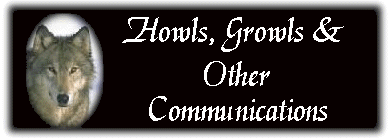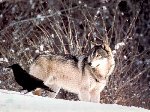

Just like any other animal, Wolves communicate in many different ways. These pages are about communication among wolves. Have you ever noticed that when one begins to bark, all of the dogs around it start to bark too? Barking, growling, and whining are some vocal ways that dogs, and their wild counterparts, wolves, communicate. But they also communicate with body language and scent.
A lot of research has been done about wolves and the way that they communicate their,feelings and needs to other wolves. They use their sense of smell to communicate by "marking" territory the way dogs do, and by scratching the ground which may leave a scent if glands that are located in the feet are stimulated.
The scent markers may have many different functions. They tell intruders that they are entering territory that belongs to another pack, or tell members of a pack that they are still inside their territory. They may also help a lost member find home or help a pack locate a lone wolf. Wolves also identify each other by their individual scents. They often "scent role" by rubbing their fur on an object and thus transferring the scent to another place.
Wolves also howl and make plenty of other verbal noises to communicate. The growl, bark, yip and whine much like the family pet dog will, and for many of the same reasons. So since everybody can pretty much figure out why a wolf would growl or bark I am going to concentrate on howling. 
Just before a howl, a wolf often whines and wags its tail. It may then lift its head and open its mouth and let out a long howl. Considerable tail wagging, excitement, and general friendliness usually accompany the howling.After a pack wolves ends the howling session, there appears to be a period of fifteen to twenty minutes or more during which wolves will not howl. This is called a "refractory" period. Researchers have come to the conclusion that wolves howl for mainly 4 reasons.
Because they like to Pack Assembly Pack Member Identification Ritual Howling 
Because They Like To:
Wolves like to howl. While resting, a single wolf may start howling. The next thing you know, every wolf in the place is howling up a storm. When wolves howl, they do not always standup and raise their heads. Many times wolves will just lay on the ground and howl. Wolves like to sing just like humans like to sing. Like humans, not all wolves have a great sounding howl. Some howls are low and mournful, they may sound sad, but they are not. Some wolves have a high pitched howl and still others have a gravely sounding howl.
Pack Assembly:
One of the main functions of howling seems to be as and aid in assembling the pack. It is not uncommon to see a wild wolf start howling and draw other pack members to it. This can be used in dense woods to bring a scattered pack together.Wolves do not howl to start a chase. They will get together in a group to howl before they go on a hunt, this was covered above. When wolves are on a chase, that is after a moose, they are silent.

Pack Member Identification:
Howling may also be used to identify a wolf. Wolves tend to have very
different howls and other wolves may know which wolf is doing the
howling. Howling could be like a fingerprint for wolves.The chart below shows information on three different wolves howling. It
is evidence that wolves can be told apart by their howl.
Ritual:
Wolves howl in a ritual fashion before a hunt. When it is time to hunt,
usually in the early evening, the pack will get together. The lower
ranking members of the pack will mob the alpha male and alpha female
for a few moments. Then the entire pack will break out in a howl. It
sounds like a chorus of wolves. You can hear the harmony. No two
wolves will howl on the same note. If two do start to howl on the same
note, one or both will change to a different note. No one knows why they
to this, but they do. Most researchers guess that they do this to make
the pack sound larger then what it really is.When the wolves return from a hunt, the wolves that stayed behind will
rush to greet them and many times a round of howling breaks out.
Wolves are very social animals and form strong bonds between other
members of the pack.
Listed below are samples that I have found of wolves howling. As you
will see, some sound mournful and some sound joyous, regardless, howling
is a language all to it's own, and one that we will probably never fully
understand.
|
|
|
|
|
|
|
|
|
|
|
|
|
|
|
|